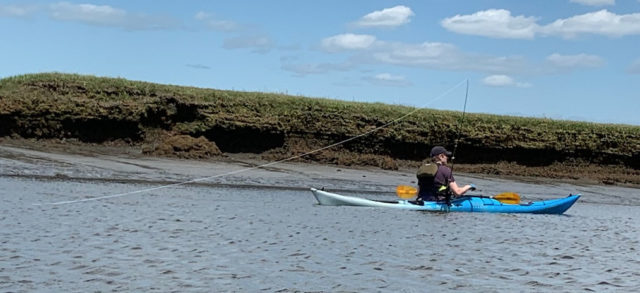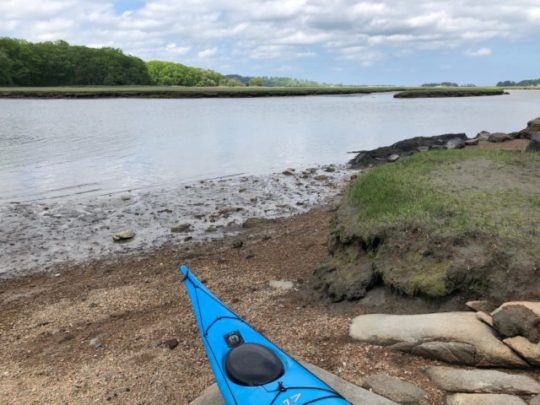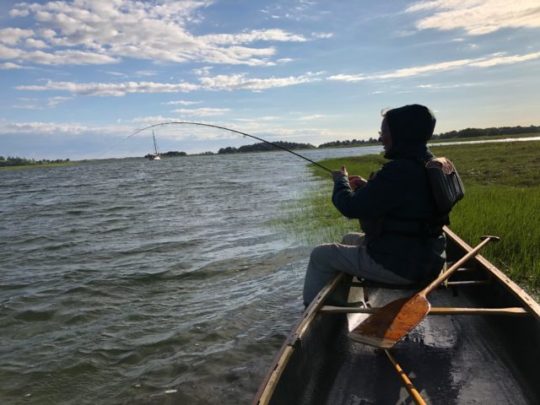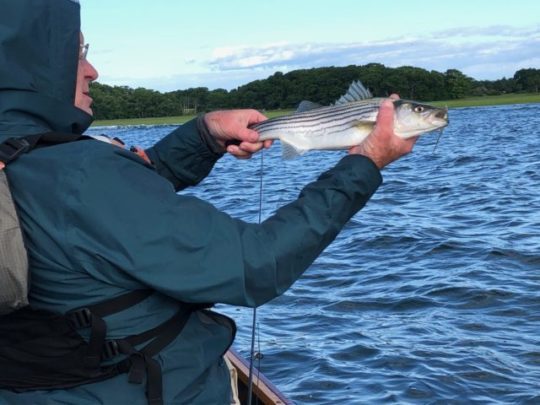Our team is very excited to welcome to the blog Dave Hyde (his bio here). This is his first post. Welcome to the team, Dave!

Hello, BlogFlyFish.com World! Great to meet you and looking forward to getting to know you. Let’s get into it.
INTRODUCTION
Trolling flies out of a canoe or kayak is an effective way to fly fish, particularly at saltwater estuaries where fish will be predictably located based on seasons and tides. Trolling is not just for offshore charter fishing or powerboats in lakes; it’s also well suited to the fly angler willing to paddle.
While kayak fishing or canoe fishing comes with its own challenges, it can also be rewarding for the adventurous who are willing to try out a new technique. Trolling levels the playing field by letting you cover a large amount of water with a stealthy presentation. While you paddle, your fly dangles in the water far behind you, away from your splashy paddle strokes. And, there’s no motor or engine noise to spook fish or turn them off from feeding.

For the fly fisher, trolling often has connotations of conventional and bait anglers in motorized watercraft. However, if you replace the casting rod with a fly rod, and the powerboat with a canoe or kayak, the same technique can be remarkably successful.
If you are willing to use your muscles and maintain good safety practices, you have the chance to out-fish other anglers using this method. While the content of this how-to guide is designed with the striped bass angler in mind, it could also be applied to freshwater situations or other saltwater scenarios.
TACKLE
No specialized tackle is necessary for trolling flies from a canoe or kayak. Generally speaking, rods in the #8 to #10 classes are preferred for striped bass due to their ability to cast large flies, cast into the wind, and fight bigger fish. Regardless of what weight rod you use, your leader should be 15-16 lb. test. 12 lb. test can be experimented with, but there’s a risk of breaking off fish.
Like in trout fishing, many anglers prefer to buy nylon leaders and then replace the last two to three feet of tippet with fluorocarbon using a double surgeons knot. To tie your fly on, a clinch knot, improved clinch knot, or non-slip loop knot will work just fine.

In terms of fly line, you have another opportunity to experiment. At a saltwater estuary, your approach will change depending on the tide level. At high tide, a 350 grain full sinking line is appropriate, while at low tide a floating line with a heavy fly is sufficient. However, you can adapt any sort of saltwater fly line to any given tide and water depth.
Around high tide, a floating line with a long leader and a heavy fly will still get strikes in a narrow tidal river. Around low tide, a sinking or intermediate line with a light fly that rides just below the surface will work.
Quality saltwater reels are expensive. While a sealed drag is not a must have, it offers protection against salt and sand seizing up the drag of a reel and ruining it. If you do not have a reel with a sealed drag, make sure that you separate the spool from the reel and rinse both pieces with fresh water and maybe a little soap after every outing. Dunking your favorite flies in fresh water to prevent rust is advisable.

For flies, the Clouser Minnow, a Lefty’s Deceiver, and the Half & Half in size 1/0 are great options. Going big is OK here. Small schoolie-sized stripers are just as likely to hit your 1/0 or 2/0 sized chartreuse and white Clouser as is a 25 inch fish.
Remember: you’re trolling, so your fly is always moving, not starting and stopping like it would be if you were normally retrieving a fly by stripping. By using a big size 1/0 Half & Half, for example, you’re making sure that any fish passing by sees your offering. Pinching barbs, sharpening hooks, and slightly bending hook points inward so as to avoid gut hooking are all recommended ethical practices for safely and quickly releasing game fish.
BOATING
Sea kayaking and saltwater canoeing by themselves are not trivial undertakings. If you are not an experienced boater, get comfortable with your craft before introducing fly fishing into the equation.
Before discussing safety, let’s start with considering complexity. Conventional kayak fishing in particular can become complex. You’ll find plenty of kayak anglers with boats laden with four or more rods attached to a milk crate and other equipment, like fish finders, anchors, and coolers. Which is fine!
However, the paddling fly angler planning to troll should strive to keep things simple with regards to equipment and only bring the tackle they will be using that day along with safety equipment. Any gear not used slows down the boat and can get in the way.
For transporting your kayak or canoe on your car, either put your kayak in J Bars such as the Thule Hull-a-port on crossbars or put your canoe directly on the crossbars. Use regular 12 to 15 foot straps, not ratchet straps, which can damage hulls.
Affix a small flag to the end of your boat at the back of your car to comply with the law and alert other motorists. Check your straps and other tie downs before, during, and after transport. This helpful post from row2k.com will remind you of how these five dollar straps can be the difference between being a boat owner and being a broken boat owner: Your Boat Straps Hate You (and, They’re Plotting Revenge).
If you do not have access to a 12 to 18 foot kayak or canoe, try to borrow or rent one. Then, if you find this technique of trolling flies successful, you’ll have a reason to make an investment! You do not need a fishing/angling kayak or canoe to be successful with this application. Lighter boats might actually be better for long days on the water trolling.
The key must-have items for a successful outing are:
-
- Personal flotation device. Treat your PFD/lifejacket like a seatbelt and do not paddle without it buckled no matter what the water temperature or time of year. No excuses!
- Whistle. One whistle means “Here I am,” two whistles mean “Where are you?,” three whistles means “Help!” In lieu of a safety flag pole, a whistle is also a good means to alert other boats to your location.
- Dry bag. You and your gear will get wet. A true dry bag like the NRS Tuff Sack is money well spent for valuables.
- A 12 to 18 foot-long boat. While you are welcome to try trolling flies for striped bass out of a smaller recreational kayak or small canoe, you may be disappointed at your slow rate of speed, your unsteadiness in boat wakes, and your lack of sealed bulkheads in case you flip. If you are going to try trolling flies for striped bass in a small recreational boat, first try paddling it in your desired location without any tackle and see how it goes.
- A paddle leash (if kayaking). Once you hook up to a fish, you will want to put your paddle down. A paddle leash lets you drop the paddle into the water without worrying about where it will be once you land the fish.
Nice-to-have items include:
-
- If in a non-angling kayak, a paddle clip, such as the Cascade Creek Yakclip
- A rod holder, such as the Scotty coaming/gunnel clamp mount for non-angling kayaks
- Paddling gloves
- Paddling booties
- A sponge for bailing
TECHNIQUE
Once you launch, it’s time to get a fly in the water. Get out into the channel where the water is deep. Get some momentum going forward with two or three strokes, strip out some line, and cast your fly out to the side closest to the river bank (starboard side) while keeping your rod perpendicular to the boat.

Resume paddling with two or three strokes, then strip out another 10 feet of line. Repeat until you have stripped out 50 feet of fly line. Position the rod either in the rod holder so that it’s not in the way of your paddle stroke, or just find a comfortable place for it in the cockpit under one of your legs. The resistance of the water pulling on the fly line should make stripping out line and keeping it behind your stern easy.
WARNING: Don’t lose your rod overboard in the heat of the battle. You are combining two challenging competencies (sea kayaking/canoeing and saltwater fly fishing), and it’s easy to make mistakes. If it’s your first time going out and you don’t feel comfortable at the beginning, stop what you’re doing and turn around and make some adjustments. No fish is worth losing your rod/reel/line or wallet/phone/keys to the bottom of the river, or otherwise damaging your equipment/boat not to mention hurting yourself.
Finding a way to paddle while also maintaining contact with your rod, either visual contact with a rod holder or physical contact by keeping it between your legs, is part of the beauty of this technique. Be mindful that it will be awkward at the start.
Now that you are paddling happily along at your favorite local tidal estuary, it’s time to find some fish. Make sure that you have plenty of fly line out. Because you’re not casting, don’t be shy about stripping out a lot of line. For fly lines that change color after the first 50 feet, strip out line until at least the color change. Every 10 to 15 minutes, check your fly to make sure that it hasn’t picked up any seaweed. Other than that, experiment with different locations in your estuary: close to the riverbank, at the mouths of tidal creeks, or in the vicinity of birds are great places to start.
When the rod bends, get excited, but don’t panic. Be aware of your surroundings. A big wave or powerboat will ruin your day if you’re not paying attention. Put your paddle in the paddle clip or paddle holder (or, in the water if you have a paddle leash), and grab the rod.
One unexpected fun aspect of trolling flies is that the fish is always on the reel – you don’t have to play the game of having to decide if you want to bring the fish in by stripping in line or getting it on the reel instead. Regardless of whether or not you’re in a canoe or kayak, brace your legs, knees, or thighs against the gunnels or interior of the boat to maintain stability while your hands are on the reel and rod. Keep your weight on your butt, as now’s not the time to go overboard!
After catching a fish on the troll, it’s not a bad idea to make some casts around the location where you hooked up, if you feel up to it. Casting to predatory or migratory fish in large schools (once you’ve found them) is a far cry from making delicate presentations to finicky trout. Even if you are blind casting in murky water, or blind trolling as the case may be, the action can be fast.
Saltwater fishing reports from around the Northeast have remarked at how fly anglers can be the most successful during springtime. This is because the only baitfish in inland waters are small. Therefore, traditional striped bass flies like the Clouser Minnow will match the hatch. Do not be surprised if you find yourself in a canoe or kayak with one rod outfishing others in motorized watercraft with multiple rods.
OTHER CONSIDERATIONS
Tides: They are just as important for safety and access as they are to finding fish. For launching and landing, the tide will determine if you are walking through ankle deep muck or smoothly coasting over a marshy shore.
The conventional wisdom is that striped bass follow baitfish into estuaries on the rising tide and then chase them back out on the falling tide. True as this may be, do not let it influence your angling too much. If you are there at the right time of year and you cover enough ground, you always have a shot to find fish by trolling no matter what the tide or water level. Whether you use a mobile app such as Ebb Tide for iPhone or Tides Near Me for Android or another information outlet, know the tides before you launch.

Weather: A 12 mph wind forecast doesn’t seem like much on land, but paddling against a breeze and a current will be slow going no matter how strong a paddler you are or how nice your boat is.
However, don’t let weather discourage you. Overcast skies, light rain, or cool temperatures may come with reduced boat traffic and fast action on the water. Allot yourself two to four hours on the water, bring water and food and a first aid kit, and do the best you can. But, if there are high winds and/or thunder or lightning in the forecast, don’t risk it.
To avoid windy conditions, launch as early as possible in the morning. Make sure that you don’t stray too far from your return point unless you can commit to paddling back to your car in the face of a stiff wind or current.
Traffic: Launching early in the morning or paddling on weekdays instead of weekends will help you avoid boat traffic. During May to July, daylight in the Northeast extends until ~9 pm. It’s feasible to fish from 6 to 8 pm on a weeknight and have an estuary all to yourself. For your first outing, don’t go out at 1 pm on a Saturday. Set aside a time during the week when boat engines won’t be putting off the fish that you’re targeting.

Be courteous to other boaters. Do not tangle their lines with your long trolling line, and reel in your line if you are in danger of fouling another angler. Mind the rules of the river. Stay to the right and follow channel markers. The simple act of waving to boats will keep you in good graces, and you may even make some friends. If you get waked, just point your bow into the wake and bob through the waves and then resume trolling. You’ll have the last laugh.
ACCESS
To get your hull wet, you need two things: a place to park your car and a place to put your boat in the water. These things are not always in the same place in a tidal estuary. Many public kayak put-ins are a short, walk-able distance away from a parking area.
In Northeast Massachusetts, certain conservation organizations maintain access for non motorized watercraft. Organizations like the Essex County Greenbelt exist to encourage recreational use of these spectacular outdoor properties.
If you’re looking for a place to start, you can’t do better than the Allyn Cox Reservation on the Essex River. Drop your boat and your gear off at the end of the road by the water, then park your car at the lot and walk back.
In Buzzards Bay, Edgewater St in Fairhaven has a fantastic little parking lot and kayak launching area. Pavilion Beach in Ipswich has great access as well.
Organizations like the Appalachian Mountain Club have books such as Sea Kayaking Coastal Massachusetts, which will introduce you to many kayak and canoe launches. Any bays, coves, inlets, and marshes in areas where striped bass thrive are all suitable for trolling.
SUMMARY
While kayak fishing can become complicated, trolling flies by kayak or canoe is a simple way to reliably catch fish. Covering a lot of ground in a stealthy fashion without having to retrieve or strip line is the magic of trolling out of a kayak or canoe. You are only limited by your ability as a paddler and boater, not your prowess at casting or double hauling or stalking fish.
Sea kayaking or canoeing is a magical way to experience the coastal environment as well. The bird life, such as ospreys, oyster-catchers, terns, egrets, and even the common cormorants and gulls, will accompany you on your journey.
Best wishes, and let me know how it goes. I’ll see you on the water!
NOTES
I would like to thank Fred Jennings of Peak Dawn Anglers for introducing me to trolling flies out of non-motorized water craft. He also showed me the value of bending hook points inwards to avoid gut hooking. Fred has written for the blog, including this post: “Extreme Peak Dawn Tides.”
If you would like to be guided in this activity, I can vouch for the quality service, fishiness, care for the resource, and enthusiasm of Geoff Klane of Brackish Flies, who has also written for this blog.
I am not paid or compensated for any links posted on this blog, and any revenue from affiliate links is donated to charity. Feel free to reach out to me on Instagram with your successes and failures. Believe me: I have plenty of both!
Discover more from BlogFlyFish.com
Subscribe to get the latest posts sent to your email.

Excellent first piece, welcome to the fold David!
Hi Dave, great read! Best, Jeff
Awesome article, good tips. Just got a topwater 120 pdl last year and got my first striper in 23 years, on the yak my first day out last september during an inshore frenzy just infront of the beach next to saltwater marshes. Hell of a lot of fun, gonna try trolling this season after reading this, thanks!
Alex – I have to know, did you have any luck?!
Great read man! Learned a lot!
Thank you for this post. Want to re-emphasize the whistle. It sounds dorky but if you get caught out in the dark or the fog it could save your life. In multiple cases, for sailors who have gone overboard at night, the whistle on the lifejacket is what allowed rescuers to find them (their flashlights or jacket lights failed quickly).
I appreciate the kind word y’all. Alex – glad to hear, let me know how it goes trolling. C Ball – absolutely, couldn’t agree more, ocean safety is a whole other world and the salt cannot be taken lightly.